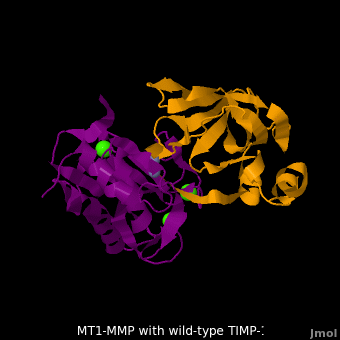Function
Matrix metalloproteinases (MMP) are Zinc-dependent endopeptidases. MMP degrades extracellular matrix proteins. They are inhibited by proteases called tissue inhibitors of metalloproteinase (TIMP). The pro-MMP contains a pro-peptide which must be removed to render the MMP active[1]. See details in
MMPs are produced by 28 different genes and are classified according to their protein substrates.
- MMP1 cleaves collagens I, II, III, VII and X.
- MMP2 cleaves collagen IV and denatured collagen.
- MMP3 cleaves the core protein of aggrecan and plasminogen activator.
- MMP7 cleaves proteoglycans, fibronectin, elastin and casein.
- MMP8 cleaves aggrecan.
- MMP9 cleaves gelatin. See details in Molecular Playground/MMP9
- MMP10 cleaves collagens III, IV, V, fibronectin,gelatin and aggrecan.
- MMP11 cleaves peptides in human tumors.
- MMP12 cleaves collagens I and III. See details in Matrix Metalloproteinase 12
- MMP13 cleaves collagen II and laminin-5 γ2.
- MMP14 is a membrane-type MMP which cleaves aggrecan. See details in Molecular Playground/MMP14
- MMP16 cleaves collagen III, proteoglycans, fibronectin, gelatin, vitronectin, laminin and α2-macroglobulin.
- MMP20 cleaves E-cadherin.
- MMP23 function is unknown.
- MMP adamalysin is a snake toxin. See details in Atragin
Relevance
MMPs have a role in cancer progression[2]. MMP-2 and MMP-9 secretion is elevated in ovarian cancer and are associated with poor prognosis[3]. MMP-8, MMP-9, MMP-13 and MMP-14 have a role in periodontal diseases[4].
MT1-MMP-TIMP-1 complex
The human matrix metalloproteinases (MMPs) family comprises a large group of structurally homologous zinc-dependent endopeptidases (e.g. (darkmagenta) and (magenta), ) that perform a wide variety of biological roles. In general, the MMPs are inhibited unselectively by all four known tissue inhibitors of metalloproteinases (TIMPs 1-4) which have 40-50% sequence identity. For example, can form complex with (1uea, colored orange). (cyan) is mainly composed of the N-terminal segment that approaches the active site, the AB loop (Thr33-Tyr35), the CD loop (Ala65-Cys70), and the EF loop (Thr97-Ser100). The pivotal residue, threonine 98 (Thr98), is shown as red sticks. In general, (Cys1-Ser68, Val69-Met66, Gly71-Met66, Cys70-Glu67, and Cys70-Thr98) are intimately involved in the conformational stability of TIMP binding interface when bound to MMP.
(darkmagenta) also forms complex with (2j0t, colored orange), producing as well as . This network of hydrogen bonds stabilizes the CD and EF loops that compose the binding interface. Importantly, the . However, this MT1-MMP-WT-TIMP-1 complex is not tight-binding. MT1-MMP is unique since even though it exhibits high structural homology to all MMPs, it is not inhibited by TIMP-1, (1bqq). (mutant TIMP-1 is colored in yellow with T98L shown in red) transformed TIMP-1 into a high affinity inhibitor of MT1-MMP (3ma2). WT-TIMP-1, WT-TIMP-2, and TIMP-1 T98L mutant have kinetic dissociation binding constant (KD) 1.53 x 10-6, 5.61 x 10-8, and 8.70 x 10-8, respectively. So, KD of WT-TIMP-2 is 2 orders of magnitude smaller than that of WT-TIMP-1, indicating the weak affinity between MT1-MMP and WT-TIMP-1. The TIMP-1 T98L mutant regained high-affinity binding to MT1-MMP, resulting in a 2 order of magnitude decrease in KD, similar to the case for WT-TIMP-2, the in vivo inhibitor of MT1-MMP. The overall structures of the complexes of MT1-MMP-WT-TIMP-1 and MT1-MMP-mutant-T98L-TIMP-1 are . Even the structure of MT3-MMP-WT-TIMP-1 is (with wild-type and TIMP-1 T98L mutant). , which is situated near the MT1-MMP . So, this T98L replacement may stabilize the entire area by establishing a strong hydrophobic core upon binding to the enzyme. However, it seems unlikely that these additional bonds could
account for the entire binding effect between MT1-MMP and TIMP-1. Statistical analysis of the stabilities in the TIMP-1 T98L mutant reveals that the hydrogen bonds network in mutant form is significantly more stable than that in WT-TIMP-1. Mutations that enhance hydrogen
bond stability contribute to the stability of the bound-like, less flexible, conformation of TIMP-1, which eventually results in increasing binding affinity for MT1-MMP. Thus, mutation affected the instrinsic dynamics of the inhibitor rather than its structure, thereby facilitating the interaction [5].
3D structures of matrix metalloproteinase
Matrix metalloproteinase 3D structures

